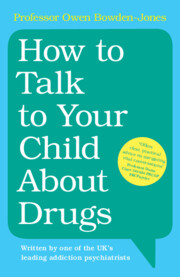Book contents
- How to Talk to Your Child About Drugs
- How to Talk to Your Child About Drugs
- Copyright page
- Contents
- Acknowledgements
- Introduction
- 1 What Are Psychoactive Drugs, Who Uses Them and Why?
- 2 Understanding Adolescence
- 3 Having the Drug Conversation with Your Child
- 4 Drugs and the Brain
- 5 How Do Drugs Cause Harm?
- 6 Types of Drugs
- 7 Rise of the Synthetics
- 8 Legal but Harmful: Prescription Medications, Tobacco, Vaping and Alcohol
- 9 Behavioural Addictions
- 10 Detecting Drug Use and What to Do about It
- 11 Treatment and Recovery
- 12 Final Thoughts
- Useful Resources
- References
- Index
6 - Types of Drugs
Published online by Cambridge University Press: 13 February 2025
- How to Talk to Your Child About Drugs
- How to Talk to Your Child About Drugs
- Copyright page
- Contents
- Acknowledgements
- Introduction
- 1 What Are Psychoactive Drugs, Who Uses Them and Why?
- 2 Understanding Adolescence
- 3 Having the Drug Conversation with Your Child
- 4 Drugs and the Brain
- 5 How Do Drugs Cause Harm?
- 6 Types of Drugs
- 7 Rise of the Synthetics
- 8 Legal but Harmful: Prescription Medications, Tobacco, Vaping and Alcohol
- 9 Behavioural Addictions
- 10 Detecting Drug Use and What to Do about It
- 11 Treatment and Recovery
- 12 Final Thoughts
- Useful Resources
- References
- Index
Summary
Stimulants like cocaine, amphetamines, and ecstasy produce short-term desirable effects like alertness, euphoria, and energy. However, they can also cause short- and long-term harm, leading to addiction, dependence, and withdrawal syndrome. Sedative drugs like cannabis, opioids, and benzodiazepines create feelings of calmness and relaxation but can be dangerous in overdose, particularly if mixed with other sedatives. Repeated use of sedatives can lead to severe dependence. Cannabis is the most commonly used illegal drug and can cause paranoia, psychosis, memory problems, and mood disorders with long-term heavy use. Synthetic cannabinoids like ‘spice’ are stronger and more harmful than natural cannabis. Hallucinogens like LSD cause distortions, hallucinations, confusion, and disorientation. They don’t cause dependence but can damage the brain with repeated use. Dissociative drugs like nitrous oxide and ketamine cause disorientation, perceptual disturbances, and loss of physical coordination, leading to accidental injury. Long-term use of ketamine can damage the bladder, and nitrous oxide can cause memory problems and severe nerve damage.
Keywords
- Type
- Chapter
- Information
- How to Talk to Your Child About Drugs , pp. 98 - 147Publisher: Cambridge University PressPrint publication year: 2025

